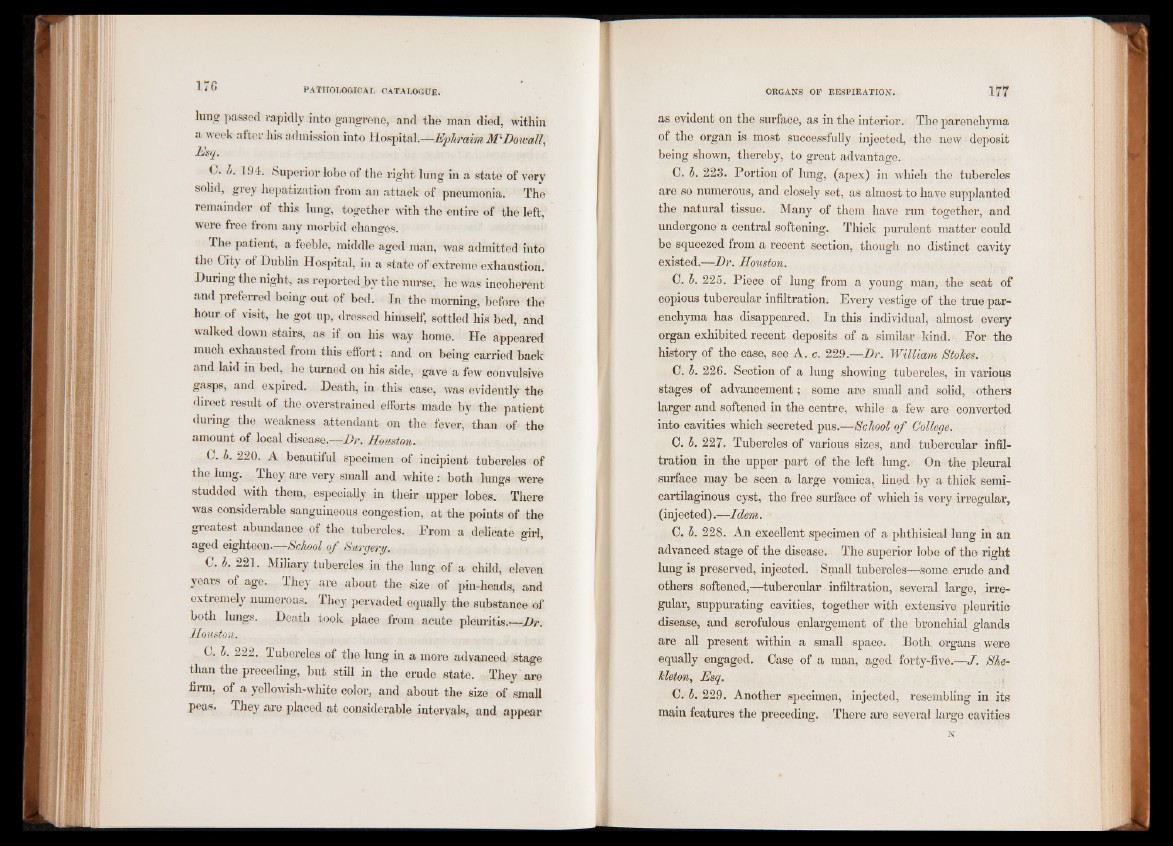
liing passed rapidly into gangrene, and the man died, within
a week after his admission Esq. into Hospital.—Ephraim M'Dowatt,
0. h. 1,94. Superior lobe of the right lung in a state of very
solid, grey hepatization from an attack of pneumonia. The •
remainder of this lung, together with the entire of the left,
were free from any morbid changes.
The patient, a feeble, middle aged man, was admitted into
the City of Dublin Hospital, in a state of extreme exhaustion.
During the night, as reported by the nurse, he was incoherent
and preferred being out of bed. In the morning, before the
hour of visit, he got up, dressed himself, settled his bed, and
walked down stairs, as if on his way home. He appeared
much exhausted from this effort; and on being carried back
and laid in bed, he turned on his side, gave a few convulsive
gasps, and expired. Death, in this case, was evidently the
direct result of the.overstrained efforts made by the patient
during the weakness attendant on the fever, than of the
amount of local disease.—Dr. Houston.
C. b. 220. A beautiful specimen of incipient tubercles of
the lung. They are very small and white: both lungs were
studded with them, especially in their upper lobes. There
was considerable sanguineous congestion, at the points of the
greatest abundance of the tubercles. From a delicate girl,
aged eighteen.—School of Surgery.
C. h. 2 2 1 . Miliary tubercles in the lung of a child, eleven
years of age. They are about the size of pin-heads, and
extremely numerous. They pervaded equally the substance of
both lungs. Death took place from acute pleuritis.—Dr.
Houston.
C. h. 222. Tubercles of the lung in a more advanced stage
than the preceding, but still in the crude state. They 'are
firm, of a yellowish-white color, and about the size of small
peas. They are placed at considerable intervals, and appear
as evident on the surface, as in the interior. The parenchyma
of the organ is most successfully injected, the new deposit
being shown, thereby, to great advantage.
C. b. 223. Portion of lung, (apex) in which the tubercles
are so numerous, and closely set, as almost to have supplanted
the natural tissue. Many of them have run together, and
undergone a central softening. Thick purulent matter could
be squeezed from a recent section, though no distinct cavity
existed.—Dr. Houston.
0. b. 225. Piece of lung from a young man, the seat of
copious tubercular infiltration. Every vestige of the true parenchyma
has disappeared. In this individual, almost every
organ exhibited recent deposits of a similar kind. For the
history of the case, see A. c. 229.—Dr. William StoJces.
0. b. 226. Section of a lung showing tubercles, in various
stages of advancement; some are small and solid, others
larger and softened in the centre, while a few are converted
into cavities which secreted pus.—School of College.
0. b. 227. Tubercles of various sizes, and tubercular infiltration
in the upper part of the left lung. On the pleural
surface may be seen a large vomica, lined by a thick semi-
cartilaginous cyst, the free surface of which is very irregular,
(injected).—Idem.
C. b. 228. An excellent specimen of a phthisical lung in an
advanced stage of the disease. The superior lobe of the right
lung is preserved, injected. Small tubercles—some crude and
others softened,—tubercular infiltration, several large, irregular,
suppurating cavities, together with. extensive pleuritic
disease, and scrofulous enlargement of the bronchial glands
are all present within a small space. Both organs were
equally engaged. Case of a man, aged forty-five.—J. She-
Jcleton, Esq.
0. b. 229. Another specimen, injected, resembling in its
main features the preceding. There are several large cavities